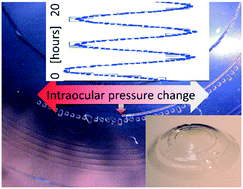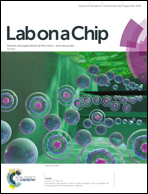Ultra-sensitive microfluidic wearable strain sensor for intraocular pressure monitoring†
Abstract
Wearable technologies have potential to transform healthcare by providing continuous measurements of physiological parameters. Sensors that passively monitor physiological pressure without using electronic components are ideal for wearable contact lenses because they are easy to interface with the cornea and the external environment. Here, we report a passive integrated microfluidic sensor with a novel transduction mechanism that converts small strain changes into a large fluidic volume expansion, detectable by a smart-phone camera. The optimization of the sensor architecture and material properties results in a linear and stable sensor response. We have shown that the sensor has a detection limit of <0.06% for uniaxial and <0.004% for biaxial strain. We embedded our sensor in silicone contact lenses and measured the intraocular pressure induced strain in porcine eyes in the physiological range. The sensor's continuous operation capability for >19 hours and a lifetime reaching >7 months demonstrate its potential for long-term ophthalmic monitoring applications.

- This article is part of the themed collection: Wearable and Implantable Sensors


 Please wait while we load your content...
Please wait while we load your content...